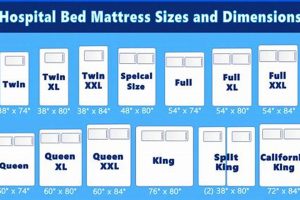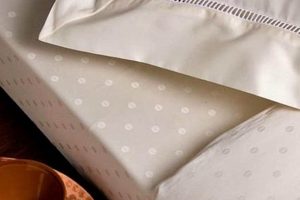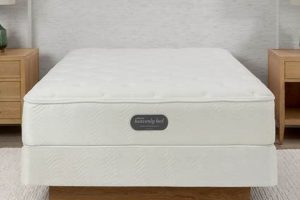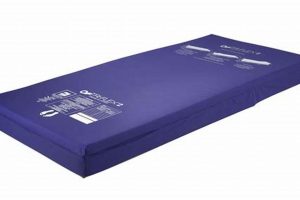A specialized support surface designed to mitigate pressure and enhance comfort is often utilized in healthcare settings. These devices typically consist of inflatable compartments that can be adjusted to redistribute weight and minimize the risk of pressure ulcers, particularly for patients with limited mobility or prolonged bed rest.
The implementation of these pressure-redistributing surfaces offers several benefits, including improved patient comfort, enhanced circulation, and a reduced incidence of pressure-related skin breakdown. Historically, simpler mattresses were the standard, but advancements in material science and engineering have led to the development of more sophisticated systems that actively monitor and adjust pressure levels based on individual patient needs. These innovations represent a significant improvement in patient care and contribute to better overall outcomes.
The following sections will delve into the different types of these support systems, their key features, maintenance requirements, and considerations for selecting the appropriate surface for various patient populations and clinical scenarios. Furthermore, the discussion will include an overview of relevant safety standards and best practices for their utilization within a hospital environment.
Guidance on Utilizing a Pressure-Redistributing Mattress in a Clinical Setting
Effective management and appropriate application of specialized support surfaces are critical for optimal patient outcomes and the prevention of pressure-related complications.
Tip 1: Patient Assessment: Prior to deployment, conduct a thorough patient assessment to determine risk factors for pressure injuries, including mobility, skin integrity, nutritional status, and presence of comorbidities. This assessment will inform the selection of the most appropriate support surface.
Tip 2: Inflation Level Calibration: Ensure the support surface is inflated to the manufacturer’s recommended pressure level. Deviations from recommended inflation can compromise the pressure redistribution capabilities and potentially increase the risk of skin breakdown. Utilize a calibrated pressure gauge for accurate inflation.
Tip 3: Regular Inspection: Routinely inspect the surface for signs of damage, such as tears, punctures, or leaks. Compromised integrity can lead to uneven pressure distribution and reduce the effectiveness of the support surface. Damaged surfaces should be immediately removed from service and replaced or repaired.
Tip 4: Proper Positioning Techniques: Implement proper positioning techniques to further minimize pressure on bony prominences. Utilize pillows and cushions to offload pressure from heels, sacrum, and other vulnerable areas. Regularly reposition the patient according to established protocols.
Tip 5: Skin Care Protocols: Adhere to established skin care protocols, including regular skin assessments, gentle cleansing, and application of moisture barriers. Proactive skin care complements the pressure redistribution capabilities of the support surface and further reduces the risk of skin breakdown.
Tip 6: Education and Training: Provide comprehensive education and training to all healthcare personnel involved in the care of patients utilizing these support surfaces. Training should cover proper inflation techniques, inspection procedures, positioning strategies, and skin care protocols.
Tip 7: Weight Limit Considerations: Adhere strictly to the manufacturer-specified weight limit. Exceeding the weight limit can compromise the mattress’s effectiveness and structural integrity, leading to inadequate pressure redistribution and potential patient safety concerns.
The diligent application of these principles maximizes the therapeutic benefits of specialized support surfaces, contributing to improved patient comfort, enhanced healing, and a reduction in the incidence of pressure-related complications.
The succeeding sections will provide a detailed examination of the diverse range of support surface options available and the specific considerations involved in their selection and implementation within various clinical settings.
1. Pressure Redistribution
Pressure redistribution is a foundational principle in the design and application of support surfaces within healthcare settings, particularly concerning specialized devices. Its effectiveness directly correlates with the prevention of pressure injuries and enhancement of patient comfort, making it a primary consideration in the selection and utilization of support systems. Effective pressure redistribution is not merely a feature but a core functional requirement.
- Immersion and Envelopment
Immersion refers to the degree to which a patient sinks into the support surface, while envelopment describes the surface’s ability to conform to the patient’s body contours. A surface that allows for greater immersion and envelopment distributes pressure over a larger surface area, thereby reducing concentrated pressure on bony prominences such as the sacrum, heels, and trochanters. For instance, a low air loss system allows immersion, distributing weight evenly. This reduces the risk of pressure sores. Proper selection of these materials affects patient comfort and reduces potential health complications.
- Alternating Pressure Technology
Alternating pressure technology involves the cyclical inflation and deflation of air cells within the mattress. This dynamic pressure modulation redistributes pressure on a timed basis, preventing prolonged pressure on any single area of the body. The cycles are determined by set time in device software to change the constant location of pressure. This is beneficial for patients with limited mobility, whose lack of movement increases the risk of pressure injury development. Consider the proper use of these support surfaces to protect these vulnerable populations.
- Zoning and Targeted Support
Some specialized support surfaces incorporate zoning, which involves varying the firmness or pressure levels in different areas of the mattress to accommodate specific body regions and pressure points. For example, a surface might provide greater support in the sacral region and less pressure under the heels. It is critical to set these pressures appropriately for patients, and this individualized attention to patients increases the benefits of pressure redistribution in this area.
- Microclimate Management
The management of moisture and temperature at the skin-support surface interface is an indirect, but significant, aspect of pressure redistribution. Excess moisture can macerate the skin, increasing its vulnerability to pressure damage. Some advanced mattresses incorporate features such as low air loss or vapor-permeable covers to wick away moisture and maintain a dry microclimate. Proper monitoring of this microclimate allows for increased success of air mattresses for hospital beds.
Collectively, these facets highlight
the multifaceted nature of pressure redistribution. By effectively addressing the principles of immersion, alternating pressure, zoning, and microclimate management, specialized surfaces can significantly mitigate the risk of pressure injuries and improve patient outcomes. The selection of an appropriate surface should be based on a comprehensive assessment of the patient’s individual risk factors and clinical needs to maximize the therapeutic benefits of the surface.
2. Infection Control
Infection control is a paramount consideration in the healthcare environment, directly impacting patient safety and overall clinical outcomes. Within this context, specialized support surfaces such as air mattresses necessitate meticulous attention to hygiene protocols and material selection to minimize the risk of healthcare-associated infections (HAIs). The porous nature of some mattress materials and the potential for fluid ingress create an environment conducive to microbial growth if not properly managed. Failure to adhere to stringent infection control practices can lead to cross-contamination and the spread of pathogens among vulnerable patients. An example of this is the potential for Clostridium difficile spores to persist on improperly cleaned surfaces, leading to recurrent infections. The selection of air mattresses must therefore prioritize materials and designs that facilitate effective disinfection and prevent microbial proliferation.
The implementation of robust cleaning and disinfection procedures is crucial for mitigating infection risks associated with these support surfaces. Healthcare facilities must establish standardized protocols for routine cleaning, utilizing EPA-approved disinfectants with proven efficacy against relevant pathogens. These protocols should address the proper cleaning of both the mattress surface and any integrated components, such as air pumps or control panels. Furthermore, meticulous attention must be paid to seams, zippers, and other areas where contaminants may accumulate. Beyond routine cleaning, barrier fabrics and impermeable covers provide an additional layer of protection, preventing fluid penetration and simplifying the disinfection process. The use of disposable mattress covers can offer an alternative approach to infection control, particularly in high-risk settings or during outbreaks.
Effective infection control involving specialized support surfaces requires a multi-faceted approach encompassing material selection, rigorous cleaning protocols, and the implementation of barrier technologies. While challenges exist in maintaining optimal hygiene in a demanding clinical environment, a proactive and systematic approach to infection control is essential for safeguarding patient well-being and minimizing the incidence of HAIs. This interconnectedness between support surface management and infection prevention underscores the importance of ongoing education, adherence to best practices, and continuous quality improvement initiatives within healthcare facilities.
3. Weight Capacity
Weight capacity is a critical parameter when selecting and utilizing specialized support surfaces, directly influencing both patient safety and the functional integrity of the equipment. Exceeding the manufacturer-specified weight limit can compromise the intended pressure redistribution properties of the support surface, potentially leading to increased risk of pressure injuries. Moreover, it can result in structural damage to the mattress, reducing its lifespan and necessitating premature replacement. Therefore, careful consideration of weight capacity is essential for ensuring optimal patient care and maximizing the investment in these specialized devices.
- Impact on Pressure Redistribution
The design of air mattresses is predicated on specific load-bearing characteristics. When the stated weight limit is surpassed, the internal air chambers may not properly inflate or deflate, disrupting the intended pressure redistribution pattern. This can concentrate pressure on bony prominences, negating the therapeutic benefits of the specialized surface. Consider the case of a bariatric patient exceeding the limit; the support surface becomes ineffective, significantly increasing the risk of pressure ulcer development.
- Structural Integrity and Durability
Exceeding the weight capacity places undue stress on the mattress’s internal components, including the air chambers, seams, and supporting frame. This can lead to premature wear and tear, resulting in leaks, tears, or complete structural failure. Regular overloading not only shortens the lifespan of the support surface but also poses a safety risk to the patient, who may experience a sudden loss of support.
- Calibration and Sensor Accuracy
Some advanced support surfaces incorporate sensors that monitor and adjust internal pressure levels to optimize pressure redistribution. These sensors are calibrated to function within a defined weight range. Exceeding the weight limit can compromise the accuracy of these sensors, leading to inaccurate pressure readings and suboptimal performance of the support surface. The sensors may provide false data if outside the weight limit of the product.
- Compliance and Warranty Considerations
Operating a support surface beyond its specified weight capacity often violates the manufacturer’s warranty. This can result in the denial of warranty claims for repairs or replacements, leading to unexpected costs for the healthcare facility. Furthermore, non-compliance with weight limits may also be a factor in regulatory inspections and audits.
Adherence to weight capacity guidelines is not merely a recommendation but a critical safety measure. Healthcare facilities must implement clear policies and procedures to ensure that all patients are appropriately assessed and matched with support surfaces that meet their individual weight requirements. Regular monitoring of support surface performance and adherence to manufacturer recommendations are essential for maintaining patient safety and maximizing the lifespan of these specialized devices. In conclusion, attention to the weight capacity influences patient outcomes and minimizes healthcare costs linked to avoidable complications.
4. Durability
The durability of an air mattress designed for hospital bed use represents a critical factor influencing its long-term cost-effectiveness and patient safety. The hospital environment presents unique challenges to mattress integrity, including frequent use, exposure to bodily fluids, and repeated cleaning cycles using harsh disinfectants. A lack of durability in these mattresses leads to premature failure, requiring frequent replacements and increasing overall healthcare expenditures. Furthermore, compromised mattress integrity, such as leaks or tears, can negatively impact the effectiveness of pressure redistribution, potentially contributing to the development of pressure injuries. High durability is not merely desirable; it constitutes a fundamental requirement for air mattresses deployed in hospital settings.
Material selection plays a central role in determining the lifespan of these specialized support sur
faces. Mattresses constructed from reinforced, medical-grade polymers exhibit superior resistance to tearing, punctures, and chemical degradation compared to those made from less robust materials. Moreover, the design of the air chambers and seams contributes significantly to overall durability. Reinforced seams and multi-layered air chamber construction enhance the mattress’s ability to withstand repeated inflation and deflation cycles without compromising structural integrity. Routine weight capacity exceedances, even intermittent ones, degrade material integrity over time. Durability also affects patient comfort and safety. Sagging, leaking, or otherwise degraded mattresses fail to offer the support and pressure redistribution benefits patients require to prevent pressure ulcers and other complications. Selecting durable mattresses reduces the need for frequent replacements and repairs, saving healthcare facilities time and resources.
In summary, the durability of an air mattress for hospital beds represents a multifaceted consideration encompassing material quality, design features, and adherence to recommended usage guidelines. Prioritizing durability translates directly into reduced long-term costs, enhanced patient safety, and improved overall clinical outcomes. Challenges remain in balancing the need for durability with other crucial factors such as patient comfort and cost. Implementing regular inspection and maintenance programs further extends the life of the mattresses. This focus supports long-term value within the healthcare setting.
5. User Interface
The user interface of an air mattress designed for hospital bed use dictates the ease and accuracy with which caregivers can operate and customize the support surface, thereby impacting both patient comfort and clinical outcomes. An intuitive and well-designed interface minimizes the risk of errors during setup and adjustment, ensuring that the mattress functions as intended to redistribute pressure and prevent skin breakdown.
- Control Panel Accessibility and Clarity
The control panel, typically located on the air pump unit, serves as the primary interface for adjusting mattress settings. Its accessibility and clarity are paramount. A panel featuring clearly labeled buttons, intuitive icons, and a readily visible display minimizes confusion and the potential for incorrect settings. For example, a control panel with unambiguous pressure adjustment controls and visual indicators for different modes (e.g., alternating pressure, static pressure) reduces the likelihood of caregivers inadvertently selecting an inappropriate setting. Complicated or poorly labeled controls can lead to suboptimal pressure redistribution, potentially increasing the risk of pressure injuries.
- Pressure Adjustment and Monitoring
Precise pressure adjustment is crucial for tailoring the support surface to the individual needs of the patient. The user interface should facilitate fine-grained control over pressure levels, allowing caregivers to optimize the mattress for patient weight, body size, and specific clinical conditions. Furthermore, real-time pressure monitoring capabilities enable caregivers to verify that the mattress is functioning within the desired parameters and to detect any potential issues, such as leaks or system malfunctions. An interface lacking precise adjustment or monitoring capabilities compromises the ability to provide individualized care.
- Alarm Systems and Alerts
Integrated alarm systems within the user interface play a vital role in alerting caregivers to potential problems. Alarms may trigger in response to low pressure, power failures, or system malfunctions, enabling prompt intervention to prevent adverse events. For example, an alarm that sounds when the mattress pressure drops below a predetermined threshold allows caregivers to quickly identify and address the issue before it leads to pressure injury development. The presence of a reliable alarm system enhances patient safety and reduces the burden on caregivers.
- Ease of Cleaning and Maintenance
The user interface should be designed to facilitate easy cleaning and maintenance, minimizing the risk of contamination and prolonging the lifespan of the equipment. Smooth, non-porous surfaces and accessible components simplify the disinfection process, reducing the potential for healthcare-associated infections. Furthermore, a user-friendly interface allows for quick access to troubleshooting guides and maintenance instructions, empowering caregivers to address minor issues without requiring specialized technical assistance. An interface that is difficult to clean or maintain can contribute to infection risks and increased maintenance costs.
In essence, a well-designed user interface enhances the functionality and usability of an air mattress intended for hospital bed use, empowering caregivers to provide optimal patient care. The accessibility, clarity, precision, and reliability of the interface directly impact the effectiveness of pressure redistribution, the safety of patients, and the overall cost-effectiveness of the support surface.
6. Patient Comfort
Patient comfort, in the context of specialized support surfaces, constitutes more than a mere amenity; it represents an integral component of effective therapeutic intervention. The use of air mattresses in hospital beds directly impacts patient comfort levels, influencing factors such as sleep quality, pain perception, and overall psychological well-being. Prolonged periods of immobility and bed rest, common in hospitalized patients, frequently lead to discomfort and agitation, which can impede recovery and exacerbate existing medical conditions. Specialized support surfaces designed to enhance comfort contribute significantly to mitigating these negative effects. For instance, an air mattress that effectively redistributes pressure minimizes the occurrence of pressure injuries, a significant source of patient discomfort. The appropriate selection of materials and adjustable features directly impacts patient satisfaction and adherence to prescribed treatment protocols.
The design and functionality of air mattresses contribute to patient comfort through various mechanisms. Adjustable firmness settings allow healthcare providers to tailor the support surface to individual patient needs and preferences. The dynamic nature of alternating pressure mattresses, for example, can alleviate pressure on bony prominences, reducing pain and discomfort. Furthermore, air mattresses that incorporate features such as low air loss technology can help regulate the microclimate at the skin-surface interface, preventing moisture buildup and skin maceration. The effect can be demonstrated when comparing an air mattress to a standard hospital mattress; the air mattress, with adjustable firmness, offers personalized support absent in the standard mattress, directly addressing the patients comfort needs. This increased comfort often translates to improved sleep patterns and reduced reliance on pain medication.
In conclusion, the pursuit of enhanced patient comfort within the hospital setting necessitates careful consideration of support surface selection. Air mattresses, when appropriately chosen and utilized, can significantly improve patient well-being by mitigating pressure-related discomfort, promoting restful sleep, and reducing the incidence of complications. While challenges remain in opt
imizing the balance between comfort, therapeutic efficacy, and infection control, the recognition of patient comfort as a crucial element of care is essential for achieving positive clinical outcomes. The future of specialized support surface technology will likely focus on further refining the design and functionality of air mattresses to maximize both therapeutic benefits and patient comfort, creating a synergistic effect that improves overall patient care and contributes to a more positive hospital experience.
7. Adjustability
Adjustability represents a core functional requirement for air mattresses designed for hospital bed use. The capacity to modify various parameters of the support surface is not merely a convenience but a necessity, directly influencing pressure redistribution, patient comfort, and overall therapeutic efficacy. Lack of adjustability would render these specialized mattresses largely ineffective, failing to address the diverse needs of a heterogeneous patient population. For instance, an elderly patient with fragile skin requires a lower pressure setting compared to an obese patient requiring maximum support. The inherent variability in patient characteristics necessitates a corresponding capacity for customization in the support surface.
The practical significance of adjustability manifests in several key areas. Pressure settings, for example, must be precisely calibrated to achieve optimal pressure redistribution, minimizing the risk of pressure injuries. Different patients will require varying levels of support based on their weight, body mass index, and specific medical conditions. The ability to adjust the firmness or pressure within different zones of the mattress further enhances its adaptability to individual patient needs. An alternating pressure function also requires adjustability; the cycle time and pressure levels need to be customizable based on individual clinical presentation and risk factors. Adjustability is not static; it is dynamic and must be responsive to the changing needs of the patient. Bed sore prevention and management can be enhanced by being able to adjust air mattress for hospital bed.
In summary, adjustability is not a peripheral feature but a foundational element in the design and implementation of air mattresses for hospital beds. Its absence compromises the therapeutic benefits of the mattress, while its effective utilization enhances patient comfort, reduces the risk of pressure injuries, and optimizes overall clinical outcomes. Challenges remain in developing user interfaces that simplify the adjustment process while maintaining precise control over critical parameters. As technology evolves, the integration of advanced sensors and automated adjustment algorithms will likely further enhance the value and effectiveness of adjustable air mattresses in the hospital setting.
Frequently Asked Questions About Air Mattresses for Hospital Beds
This section addresses common inquiries regarding specialized support surfaces used within healthcare settings. The intent is to provide clarity and ensure appropriate utilization for patient care.
Question 1: What is the primary purpose of an air mattress designed for a hospital bed?
The principal function involves pressure redistribution to minimize concentrated pressure on bony prominences, thus reducing the risk of pressure injuries. These specialized surfaces are intended for patients with limited mobility or those at elevated risk for skin breakdown.
Question 2: How often should the pressure settings on an air mattress be adjusted?
Pressure settings should be evaluated and adjusted at minimum once daily, or more frequently as dictated by the patient’s clinical condition and changes in weight or positioning. Regular assessment ensures optimal pressure redistribution and mitigates the risk of pressure injuries.
Question 3: What cleaning protocols should be followed for air mattresses in a hospital environment?
Adherence to established hospital infection control protocols is mandatory. Air mattresses should be cleaned and disinfected between patients using EPA-approved disinfectants. Particular attention should be paid to seams, zippers, and other potential areas of contamination.
Question 4: What are the contraindications for using an air mattress?
Certain conditions may contraindicate the use of an air mattress. Instances of unstable spinal fractures, or patients requiring a firm, flat surface for specific medical reasons preclude its use. The prescribing physician should assess appropriateness.
Question 5: How does one determine the appropriate weight capacity for an air mattress?
The manufacturer’s specified weight limit should never be exceeded. Patient weight must be accurately assessed and matched with a support surface that meets the individual’s weight requirements. Failure to adhere to weight limits compromises mattress integrity and patient safety.
Question 6: What should be done if an air mattress develops a leak or malfunction?
If a leak or malfunction is detected, the mattress must be immediately removed from service. The issue should be reported to appropriate personnel for repair or replacement to prevent pressure injuries.
These questions and answers highlight key considerations. Consistent adherence to guidelines optimizes patient comfort and minimizes complications. Air mattress for hospital bed is effective when done correctly.
The subsequent section will address troubleshooting common issues associated with air mattresses.
Concluding Remarks on Air Mattress for Hospital Bed Implementation
This exploration has examined the multifaceted considerations surrounding the air mattress for hospital bed, emphasizing aspects from pressure redistribution and infection control to weight capacity, durability, user interface, patient comfort, and adjustability. Understanding these elements is paramount for effective implementation and achieving optimal patient outcomes in healthcare settings. Properly utilized, this specialized support surface contributes significantly to pressure injury prevention and enhanced patient well-being.
The continued advancement of technology and refinement of clinical protocols will undoubtedly lead to further improvements in support surface design and utilization. Vigilance in adhering to best practices, proactive monitoring of patient needs, and ongoing education of healthcare professionals remain essential for maximizing the benefits of the air mattress for hospital bed and ensuring the highest standards of patient care. The serious use of air mattress for hospital bed will enhance the benefit and reduce the risk.







